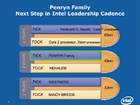Monday, August 6th 2007

Intel Sheds Light on Penryn Enhancements
With Intel's Penryn set to launch next quarter, Intel has decided to shed some light on improvements it has made to the architecture, and prove that Penryn is not just a shrunk Conroe.
Intel has decided to improve existing Wide Dynamic Execution, Advanced Smart Cache, Advanced Digital Media Boost and Intelligent Power Capability, technologies that previously made their debut with Conroe and Merom.
Below is Intel's Tick-Tock long term roadmap, as well as "Penryn" plans (source: HKEPC)Penryn enhances Wide Dynamic Execution technology with a fast radix-16 divider and improved Virtualization technology, which should boost divide instruction capability and reduce virtual machine transition latencies by 25-to-75%.
Advanced Smart Cache not only increases the cache size (6MB and 12MB L2-cache on dual and quad-core CPUs, respectively), but also reduces its latency.
Advanced Digital Media Boost technology is the inclusion of a new Intel SSE4 instruction set. SSE4 introduces 47 new instructions to improve performance of video accelerators, graphics building blocks and streaming load. Intel claims a 2x performance gain in video acceleration tasks. There are 14 new instructions for video accelerator performance enhancement. Intel improves compiler auto-vectorization performance with 32 new instructions.
Intel expects SSE4 optimizations to deliver performance improvements in video authoring, imagine, graphics, video search, off-chip accelerators, gaming and physics applications.
Mobile Penryn processors receive enhanced power saving technologies. New to the mobile Penryn is a deep power down state. In the deep power down state, the processor lowers the core voltage, more so than in the C4 state, and turns off the L1 and L2 caches. Intel claims significant power savings in idle modes for extended battery life with the new power state.
Source:
DailyTech
Intel has decided to improve existing Wide Dynamic Execution, Advanced Smart Cache, Advanced Digital Media Boost and Intelligent Power Capability, technologies that previously made their debut with Conroe and Merom.
Below is Intel's Tick-Tock long term roadmap, as well as "Penryn" plans (source: HKEPC)Penryn enhances Wide Dynamic Execution technology with a fast radix-16 divider and improved Virtualization technology, which should boost divide instruction capability and reduce virtual machine transition latencies by 25-to-75%.
Advanced Smart Cache not only increases the cache size (6MB and 12MB L2-cache on dual and quad-core CPUs, respectively), but also reduces its latency.
Advanced Digital Media Boost technology is the inclusion of a new Intel SSE4 instruction set. SSE4 introduces 47 new instructions to improve performance of video accelerators, graphics building blocks and streaming load. Intel claims a 2x performance gain in video acceleration tasks. There are 14 new instructions for video accelerator performance enhancement. Intel improves compiler auto-vectorization performance with 32 new instructions.
Intel expects SSE4 optimizations to deliver performance improvements in video authoring, imagine, graphics, video search, off-chip accelerators, gaming and physics applications.
Mobile Penryn processors receive enhanced power saving technologies. New to the mobile Penryn is a deep power down state. In the deep power down state, the processor lowers the core voltage, more so than in the C4 state, and turns off the L1 and L2 caches. Intel claims significant power savings in idle modes for extended battery life with the new power state.


53 Comments on Intel Sheds Light on Penryn Enhancements
AMD must get and stay ahead in the performance area backed up with a very clever and aggressive business strategy, in the past they have achieved the former yet still failed to gain significant market share from Intel.
AMD needs to really cut into Intel's worldwide market share, we're talking about HUGE market share gains of 30%> 40%> 50% of the total CPU market, not exactly an easy task when such companies force OEM's to stock nothing but "Intel inside" PC's, any PC maker that refuses will be denied Intel chips and/or find their rival PC makers get Intel chips much cheaper as retaliation from Intel.
However, and I stand by this, IF AMD can offer reasonable priced chips to compete with Intel and still have a nice OC ceiling, they will do just fine. Beat them if you can AMD, but if you spar well enough to keep it even and you offer great performance at a reasonable price, you will do well enough to take a good market share of Intels world. Also, some direct advertising (tv mainly) will definately help.
To put it in it's simplest terms, taking out integer and floating point, look at SuperPI which is probably concentrating on Bus efficiency and instruction pipeline efficiency........raw speed and simple short calculations (so prob not Integer of float) you can see just how far ahead Intel is, thats not to say that AMD wont catch them......I am sure they will, just hope it's sooner rather than later.
Let's not forget, when the AMD64 was dominant, some of the P4's still beat it in some processes.....video encoding for example.
Of course AMD beat Intel on some things , even clock for clock....point is Intel beat AMD on MOST things so across the board Intel is faster, clock for clock upto 15-20% :eek:....forgot, I am an AMD fanboi :cry: Point is if AMD were not faster in somethings they would not sell any chips! because there is not really any like for like bang for buck arguments in favour of AMD anymore, just look at the prices of the lower end C2D's now, even in the UK you can get them for approx £40 :eek: and they will still clock above 3 Gig, shit in the UK you can now get 2 C2D's for the price of a 6000+)
The prices are right in line for average consumers, so the bang for the buck argument is still there, just not for us overclockers.